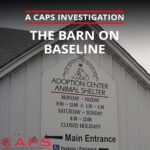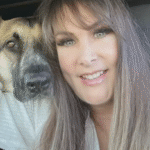Breeder: Mitzel, Frank
Business name: Mitzel Kennel
Address: 104 St. Box 74
City, State Zip: Artas, SD 57437
Year: 2005
USDA License: 46-A-0241
Date of CAPS Investigation: 2005-07-23
Time of CAPS Investigation: 12:52
On the property at the time of investigation: About 80 dogs and 25 puppies
Breeds: Standard Poodles, English Springer Spaniels, Golden Retrievers, Basset Hounds, Mastiffs, St. Bernards, Tibetan Mastiffs, Eskimos, Bull Mastiffs, Australian Shepherds, Boxers, Shiba Inus, Goldendoodles, Labradoodles, Labradors, Newfoundlands, Huskies
Four kennel structures existed on the property. One building, located about 100 feet south of the house on the property, was enclosed with metal walls on three sides, a metal roof, concrete flooring, and a chain link wall facing east. The structure itself was one large pen, about fifty feet wide and long, with five St. Bernards and a two-month-old Labrador puppy inside.
Wooden walls stood about six feet tall inside the pen. The white surfaces of these walls were scratched and worn in many places (3.1(c)(1)-Surfaces). The only shelter inside the pen was a five-foot-wide rubber tire with no covering over it. It was large enough for one Labrador puppy to fit inside (3.4(b)-Shelter from the elements). The puppy had a large bloody sore on the top of its right ear (2.40-Vet Care).
The floor had a thin layer of sawdust covering it. A plastic water bucket and food dishes were not placed so as to minimize contamination by excreta or pests (3.9(b)-Feeding).
Second building
Another structure sat at the southeast corner of the property. It contained two outdoor pens with rusting, galvanized wire walls (3.1(c)(1)(i)-Surfaces) and dirt floors. Tarps acted as windbreaks, covering about a single ten-foot section of each pen towards the south, though the pens were about 30 foot across in every direction.
There were two plastic dog houses in each pen that lacked windbreaks (3.4(b)(3)-Shelter from the elements). One pen housed two Labradors, and the second housed three Labradors. In the cage housing three dogs, only one dog could fit in the dog house and turn about freely or lie in a normal manner at one time (3.4(b)-Shelter from the elements).
Food and water dishes on the pen flooring were not placed in a manner so as to minimize contamination by excreta or pests (3.4(b)-Shelter from the elements).
Third building
A kennel structure about 200 feet west of the house contained six pens inside a barn that was open on one end. One pen, about 60 feet long and wide, contained three Labradors, a Mastiff, and two Standard Poodles.
This pen had dirty flooring (3.1(c)(3)-Surfaces). Both end walls of this pen were galvanized-wire; one end faced a hallway in the building and the opposite end was exposed to the outside. A torn and shredded tarp partially covered this end (3.3(d)-Shelter from the elements). Food dishes on the floor were not placed in a manner that would minimize contamination by excreta or pests (3.9(b)-Feeding).
Pens on either side of the hallway were constructed of galvanized wire, plastic walls, and wooden walls. Each pen was about five feet wide and eight feet long. One pen housed two Golden Retrievers, two Standard Poodles, and an English Springer Spaniel. These dogs measured from 2.5 to four feet long, and the pens were overcrowded (3.6(c)(1)(i)-Space).
The white plastic and wooden walls were all covered in dirty build-up (3.1(c)(3)-Surfaces), and the wooden walls had areas that were scratched and chewed (3.1(c)(1)-Surfaces).
The concrete floors had a thick layer of wood shavings on them. Each pen contained a metal water bucket. Food dishes on the pen floors were not placed in a manner that would minimize contamination by excreta or pests (3.9(b)-Feeding).
Another pen contained four Basset Hounds, another three Golden Retrievers, and the rest each contained a whelping Golden Retriever with several puppies. The pens closest to the entrance of the building, which was at its south end and consisted of a metal gate with no covering, did not have any shelter from possible rain or snow that could easily reach them through the open entrance (3.3(d)-Shelter from the elements).
Fourth building
The last kennel building was at the southwest end of the property and contained a variety of indoor pens and about ten indoor/outdoor enclosures. Metal doggie-doors provided access to each part of the enclosure. One pen with four Golden Retrievers had a doggie-door that was stuck open, leaving nothing to cover the doorway (3.3(d)-Shelter from the elements). The pens contained two to four dogs each, including Golden Retrievers, Eskimos, Huskies, Boxers, Standard Poodles, St. Bernards, and Tibetan Mastiffs. Several of the pens contained small litters of nursing puppies. Three Standard Poodles in one pen had matted fur full of feces (2.40-Vet Care).
The outdoor pens were concrete slabs surrounded by chain link walls, about four feet wide and ten feet long. The floor of most of these pens had several days’ accumulation of feces covering the surface and built up around the walls of the pens (3.11(a)-Cleaning of primary enclosures). A pen containing four Eskimos did not have more than a day’s accumulation of fecal matter in it.
The metal walls at the back of each pen were covered in fecal stains (3.1(c)(3) Surfaces). Metal buckets were placed on the outside walls of the pens and food dishes were placed on the inside walls. The food dishes were chewed and worn around their edges, and covered in dirty build-up (3.9(b)-Feeding).
The indoor pens, about four feet wide and five feet long, had concrete floorings covered in a thin layer of wood chips and plastic walls with dirty build-up on their surfaces (3.1(c)(3)-Surfaces). Some of the wooden walls were chewed and scratched in large areas (3.1(c)(1)-Surfaces). One pen contained three Labradors and a Husky that were each about four feet long. Another pen contained three, four-foot-long Standard Poodles, and a third contained three, 3.5-foot-long Golden Retrievers (3.6(c)(1)(i)-Space).
About six other pens were located in this kennel building. They had concrete floors, plastic and wooden walls, and galvanized wire doors on one side. Many of the wire doors of the inside pens were rusting (3.1(c)(1)(i)-Surfaces).
One pen contained two Bull Mastiffs, another had a Labrador and three Newfoundlands, another five Labradoodles, another four Basset Hounds, another five Shiba Inus, and another five Eskimo puppies. Food dishes on the pen floors were not placed so as to minimize contamination by excreta or pests (3.9(b)-Feeding). The Shiba Inus’ food dish was a rusting iron skillet (3.9(b)-Feeding).
None of the sheltered housing facilities had sufficient lighting (3.3(c)-Lighting). Flies swarmed around all of the kennel structures at Mitzel’s property (3.11(d)-Pest control).
Download attachments:Mitzel.pdf




